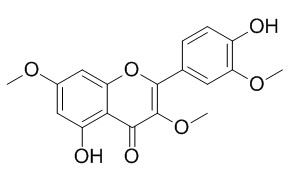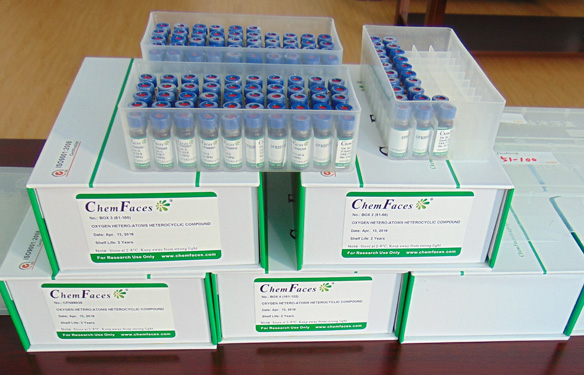Pachypodol
Pachypodol has antibacterial and antifungal activities against Bacillus subtilis, Staphylococcus aureus, Staphylococcus faecalis, Echerichia coli, Pseudomonas aeruginosa, Candida albicans, Candida krusei and Candida galabrata. Pachypodol has cytotoxic potential , it can inhibit the growth of CaCo 2 colon cancer cell line in vitro. Pachypodol exhibits anti-emetic effects.
Inquire / Order:
manager@chemfaces.com
Technical Inquiries:
service@chemfaces.com
Tel:
+86-27-84237783
Fax:
+86-27-84254680
Address:
1 Building, No. 83, CheCheng Rd., Wuhan Economic and Technological Development Zone, Wuhan, Hubei 430056, PRC
Providing storage is as stated on the product vial and the vial is kept tightly sealed, the product can be stored for up to
24 months(2-8C).
Wherever possible, you should prepare and use solutions on the same day. However, if you need to make up stock solutions in advance, we recommend that you store the solution as aliquots in tightly sealed vials at -20C. Generally, these will be useable for up to two weeks. Before use, and prior to opening the vial we recommend that you allow your product to equilibrate to room temperature for at least 1 hour.
Need more advice on solubility, usage and handling? Please email to: service@chemfaces.com
The packaging of the product may have turned upside down during transportation, resulting in the natural compounds adhering to the neck or cap of the vial. take the vial out of its packaging and gently shake to let the compounds fall to the bottom of the vial. for liquid products, centrifuge at 200-500 RPM to gather the liquid at the bottom of the vial. try to avoid loss or contamination during handling.
Aging (Albany NY).2023, 15(24):15557-15577.
J Agric Food Chem.2017, 65(13):2670-2676
Sci Rep.2018, 8:15059
Molecules.2019, 24(23):E4303
Natural Product Communications2022, 7(3):1-7.
Plants.2024, 13(10):1348;
Compounds.2023, 3(1), 169-179.
Appl Microbiol Biotechnol.2018, 102(12):5105-5120
Talanta Open2023, 7:100227
Integr Cancer Ther.2018, 17(3):832-843
Related and Featured Products
Phytother Res. 2008 Dec;22(12):1684-7.
Pachypodol, a flavonol from the leaves of Calycopteris floribunda, inhibits the growth of CaCo 2 colon cancer cell line in vitro.[Pubmed:
18570232]
Calycopteris floribunda Lam., commonly known as 'goichia lata or goache lata', is a large climbing woody shrub from Bangladesh, and well distributed in a number of other south-east Asian countries.
Traditionally, C. floribunda has been used in colic, as an antihelminthic, astringent and carminative, and for the treatment of diarrhoea, dysentery, jaundice and malaria in many countries including Bangladesh.
METHODS AND RESULTS:
Pachypodol (5,4'-dihydroxy-3,7,3'-trimethoxyflavone) has been isolated from the leaves of C. floribunda by repeated column chromatography on silica gel, and the structure confirmed by spectroscopic means. While the general toxicity of Pachypodol was determined by the brine shrimp lethality assay, the cytotoxic potential of this flavonoid has been evaluated by the Promega's CellTiter 96 Non-Radioactive Cell Proliferation Assay using the CaCo-2 colon cancer cell line (IC(50) = 185.6 microM). A summary of the biological activities of Pachypodol reported to date is also presented.
J Agric Food Chem. 2006 Feb 22;54(4):1217-21.
Pachypodol from Croton ciliatoglanduliferus Ort. as water-splitting enzyme inhibitor on thylakoids.[Pubmed:
16478239]
METHODS AND RESULTS:
A bioactivity-guided chemical study of aerial parts of Croton ciliatoglanduliferus Ort. led to the isolation for the first time of the flavonoids retusin (5-hydroxy-3,7,3',4'-tetramethoxyflavone) (1) and Pachypodol (5,4'-dihydroxy-3,7,3'-trimethoxyflavone) (2) from the n-hexane extract. Compounds 1 and 2 were separated by preparative thin-layer chromatography. Compound 2 was the most active compound on ATP synthesis inhibition. The I50 value was 51 microM. Pachypodol behaves as a Hill reaction inhibitor. It inhibited the uncoupled electron flow on photosystem II partial reaction from water to dichlorophenol indophenol (DCPIP) and from water to sodium silicomolybdate. However, the uncoupled partial reaction from diphenylcarbazide to DCPIP and the uncoupled photosystem I from DCPIPred to MV were not inhibited by 2. These results were corroborated by fluorescence decay data.
CONCLUSIONS:
Therefore, Pachypodol inhibits the water-splitting enzyme activity. Compound 1 with a 4'-methoxy group was a weak inhibitor, indicating that the 4' free -OH group is important for strong inhibition.
Pharm. Biol., 2003, 41(7):483-6.
Antifungal Flavonoids from Ballota glandulosissima.[Reference:
WebLink]
METHODS AND RESULTS:
The flavonoids kumatakenin (1), Pachypodol (2), 5-hydroxy-7,3′,4′-trimethoxyflavone (3), velutin (4), salvigenin (5), retusin (6) and corymbosin (7) have been isolated from the aerial parts of Ballota glandulosissima Hub.-Mor & Patzak. Among them, 2–4 and 7 have not been reported previously in the genus Ballota. The antibacterial and antifungal activities of 1–4 and 6 were tested against Bacillus subtilis, Staphylococcus aureus, Staphylococcus faecalis, Echerichia coli, Pseudomonas aeruginosa, Candida albicans, Candida krusei and Candida galabrata.
Phytomedicine. 1999 May;6(2):89-93.
Anti-emetic principles of Pogostemon cablin (Blanco) Benth.[Pubmed:
10374246 ]
METHODS AND RESULTS:
Bioassay-guided fractionation of anti-emetic extracts and constituents of 8 traditional Chinese herbal drugs was performed. Twenty extracts described in Table 1 showed anti-emetic activity on copper sulfate induced-emesis in young chicks. From the n-hexane extract of Pogostemon cablin, patchouli alcohol (1), pogostol (2), stigmast-4-en-3-one (3), retusin (4), and Pachypodol (5) were tested and exhibited anti-emetic effects.
Microbiol Immunol. 2015 Apr 17.
Phosphatidylinositol 4-Kinase III Beta is the target of oxoglaucine and pachypodol (Ro 09-0179) for their anti-poliovirus activities, and locates at upstream of the target step of brefeldin A.[Pubmed:
25891300]
In recent years, phosphatidylinositol 4-kinase III beta (PI4KB) has emerged as a conserved target of anti-picornavirus compounds.
METHODS AND RESULTS:
In the present study, PI4KB was identified as the direct target of the plant-derived anti-picornavirus compounds, oxoglaucine and Pachypodol (also known as Ro 09-0179). PI4KB was also identified as the target via which Pachypodol interferes with brefeldin A (BFA)-induced Golgi disassembly in non-infected cells. Oxysterol-binding protein (OSBP) inhibitor also has interfering activity against BFA. It seems that this interference is not essential for the anti-poliovirus (PV) activities of BFA and PI4KB/OSBP inhibitors. BFA inhibited early to late phase PV replication (0 to 6 hr postinfection) as well as PI4KB inhibitor, but with some delay compared to guanidine hydrochloride treatment. In contrast with PI4KB/OSBP inhibitors, BFA inhibited viral nascent RNA synthesis, suggesting that BFA targets some step of viral RNA synthesis located downstream of the PI4KB/OSBP pathway in PV replication.
CONCLUSIONS:
Our results suggest that PI4KB is a major target of anti-picornavirus compounds identified in vitro for their anti-picornavirus activities and for some uncharacterized biological phenomena caused by these compounds, and that BFA and PI4KB/OSBP inhibitors synergistically repress PV replication by targeting distinct steps in viral RNA replication.



